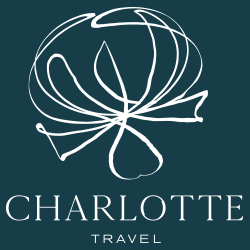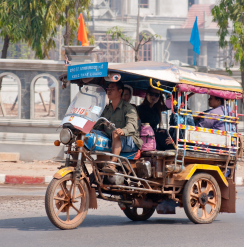From its architectural gems and rich cultural heritage, to its spectacular scenery, this comprehensive nine day journey offers an in-depth look at this magical country Laos, taking a boat trip on Nam Ngum Lake, sightseeing in the Plain of Jars (Sites I and II) and Muang Khoun and visiting Mount Phousi for sunset.
-
Day 1
Vientiane
After arriving in Vientiane, enjoy an excursion is to an open air museum, Wat Xieng Khuan (Buddha Park). This site hosts an eclectic collection of whimsical but compelling statues of Buddhist and Hindu gods. Overnight in Vientiane.
-
Day 2
Vientiane
The capital city of Laos, Vientiane still feels like a sleepy city with relaxed charm, tree-lined boulevards, beautiful temples and colourful markets. Explore the city’s highlights, including That Luang, a gleaming golden stupa which is perhaps the most important national monument in Laos; Ho Pha Keo, the formal royal temple, now a museum with beautiful examples of Buddhist sculpture; Wat Si Saket, Patuxai, a monumental arch inspired by the Arc de Triomphe, but executed with Lao motifs and Wat Si Muang. End your day at the Talaat Sao, or “morning market” (actually open all day), the best place to buy traditional Lao fabrics. Overnight in Vientiane.
-
Day 3
Vientiane to Vang Vieng
Drive to the north through the scenic province of Vientiane. The climate is pleasant and the views are beautiful passing mountains and cliffs along the first part of the journey. Visit a salt field in Ban Keun and continue for a boat ride on Nam Ngum Lake, a serene, manmade reservoir which also generates a portion of the electricity sold to Thailand. Stop at Talat fish market in Huay Mor before continuing to Vang Vieng. Overnight in Vang Vieng.
-
Day 4
Vang Vieng to Phonsavanh
Depart from Vang Vieng for Phonsavanh (Xieng Khuang), stopping to explore Tham Phom Hom Cave. Overnight in Phonsavanh.
-
Day 5
Phonsavanh, Plain of Jars, Muang Khoun and Phonsavanh
Start the day visiting local markets and continue to the famous Plain of Jars, a vast area extending around Phonsavanh from the south-west to the north-east. Mysterious and ancient, over 300 huge stone jars apparently carved out of solid rock are scattered around the plateau. The jars vary in size from 1 to 3.25 meters high and weigh up to six tons each. There are several different theories as to the purpose of the jars, which are estimated to be 2,500 to 3,000 years old. According to local legend, King Khun Chuang had them constructed in order to store wine for the celebration of his conquest of the province in the 6th century.
Afterwards continue to Muang Khoun, an ancient capital and stronghold for the Xieng Khuang royal family which was destroyed during the Indochina War. The town was rebuilt after 1975 with rows of wooden Lao houses and a market area and is surrounded by beautiful mountain scenery. Visit Wat Phia, That Foun and That Chomphet. Overnight in Phonsavanh.
-
Day 6
Phonsavanh to Luang Prabang
A slow journey along mountain roads with stunning views of the forested mountains, lush valleys and karst formations. Stop at Muang Sui, visiting the scenic Nong Tang Lake, rimmed with limestone cliffs; and the extensive cave network of Tham Pha Cave. Only discovered recently, this cave contains a 5m high Buddha image dating from 777 AD, surrounded by gold and wooden statues of smaller sizes. Overnight in Luang Prabang.
-
Day 7
Luang Prabang
Set between the Nam Khan and Mekong rivers, Luang Prabang is an enchanting town filled with historic temples and colonial style buildings. The entire town was declared a UNESCO World Heritage Site in 1995. Start the day at Wat Visoun (Wat Wisunalat). The oldest living temple in Luang Prabang, Wat Visoun dates back to 1513 and contains a collection of antique wooden Buddhas. Visit the nearby Wat Aham before continuing to Wat Xieng Thong, the crowning jewel of all the monasteries and temples in the city. Its many ornate buildings feature exquisite mosaic and gold-stencilled murals. From there, stroll down the main street of Luang Prabang, stopping at some of the many temples that line its sides, including Wat Sibounheuang, Wat Si Moungkhoun, Wat Sop and Wat Sene.
Continue to the National Museum (royal palace), a modest but graceful building which combines traditional Lao and French beaux-arts motifs. This turn-of-the century royal residence has been preserved as it was when the royal family last lived here and provides unique insights into the history of Laos. Then, visit Hor Phrabang. In the right front corner room of the Palace which opens to the outside, is a collection of the palace’s most prized art, including the Phrabang, cast of a gold, silver and bronze alloy. This Buddha stands at 83 cm tall and weighs around 50 kg.
Close the day with a lovely sunset view at Mount Phousi. Climb 328 steps starting from the entrance on the opposite side of National Museum or 410 steps on the other side of Khan River to the small temples atop Phou Si, the 150m high hill which sits in the middle of the town, offering beautiful views over the temples and river. Overnight in Luang Prabang.
-
Day 8
Luang Prabang
Travel up the Mekong River to the steep limestone cliffs overlooking the Mekong and Nam Ou rivers, home to the Tham Pak Ou Caves. These extraordinary caves are filled with Buddha images, of every style and material imaginable. On the way to Pak Ou Cave, stop at Ban Xang Hai Village, a local village famous for the production of lao lao, the local rice wine whisky. (If scheduling permits, it’s open 6.00 am – 15.00 pm and closed every major Buddhist holiday)
Experience even more of the natural beauty of Laos with a visit to Kuang Si Waterfalls. This waterfall is located in a perfect natural setting near Luang Prabang, this multi-tiered waterfall tumbles over limestone formations into a series of turquoise pools. Enjoy swimming in the clear water or just relaxing in the natural environment. Visit a local village (Ban Ou or Ban Na Ouane) on the way, before returning to Luang Prabang by vehicle.
Gain insight into the culture of Laos with visits to local handicraft villages. Visit the weaving village of Ban Xang Khong, and Ban Xang Khong, well known for its traditional handwoven cotton and silk, as well as production of the local sa (mulberry) paper. Overnight in Luang Prabang.
-
Day 9
Luang Prabang
Leisure today. Transfer to the airport to catch your connecting flight home.








